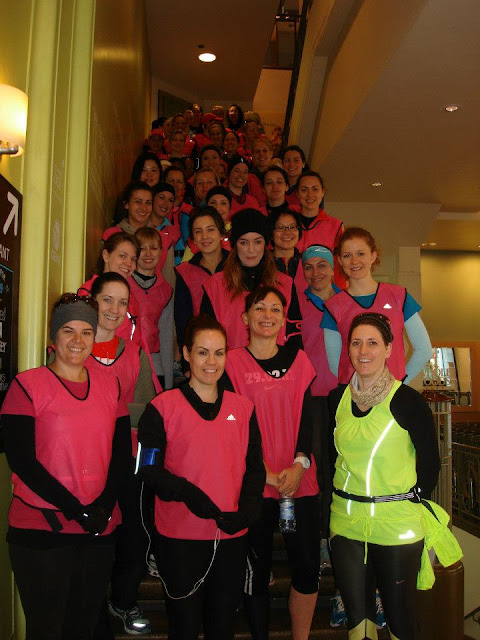One of the things I love about London is how people pour their heart and soul into their community. Whether their passion is cycling, singing, the environment, their local neighborhood, rescued animals, or bee keeping, you can find your tribe somewhere within the M25. Experts come together to teach the novice. The group may host an open day event in the hopes to spark.the interests of others. These hobbies offer a commonality that might not be found at work or at home. A release. A kinship.
I was lucky when I moved to London from the USA to find a Glee-esque show choir with Starling Arts. Much like my drama club friends from high school, I knew I could burst into song at any time with my choir mates without any strange looks. Starlings tend to love theatre, sing-a-long cinema showings, and Pitch Perfect. Coming from all walks of life, we had a love of singing (not as much with dancing) that we bonded over every Tuesday night in Pimlico.
 |
| Starling Arts’ FORTE at our summer fete |
Unfortunately, when I moved out to North London to be closer to work, I would get home very late on a work night after choir. When we moved to East London, my commute was super long and the dog needed to be let out. I am still sad that I don’t go to choir anymore (because of #tracktuesday). Many of my choir mates are still rehearsing with Starling Arts and I keep tabs on them via Facebook. I am proud to see the founders, Anna and Emily, have built a successful company and made Starling Arts their full-time gigs.
 |
| Whole Foods/Boutique Sport run club from Piccadilly Circus |
My other passion, aside from theatre, is- you guessed it- sport. When I started my blog in 2012, I didn’t think I would ever be able to run a marathon. Over the years, my love for running has slowly developed due to the people I have met through the sport. Now I hate missing #tracktuesday with Advent Running and most of my holidays have a race on the itinerary. I have also become a Leader in Running Fitness with England Athletics, followed by Coach In Running Fitness, due to this inspiring and supportive community. Both of these certifications mean I am qualified to lead run clubs, amongst other things. I have been invited to many one-off run events for brand launches and attended ones put on by running stores. This month, I am volunteering to be one of the run leaders at the Love Trails Festival. Being a run leader is not as easy as it looks so here are my top five tips on how to be a fantastic run club leader.
1. Stay with the last runner. No one wants to be the last person to cross the finish line. Slower runners (and remember each person percieves ‘slow’ differently) might be nervous when attending run clubs that they will be judged for their pace and get left behind. Even worse, they might be worried they will get lost if they fall too far behind the group. A good run club leader will realize the workout is for other people and not worry about the pace. Staying with the last runner gives them confidence and makes sure that no one is lost along the way.
2. Review the safety rules before you head out and follow them. When I lead a run clun, my rules are to always stay on pavement; be aware of pedestrians, cyclists and cars in the road, especially at junctions; follow the green man rather than blindly crossing the road because someone else did. I make sure I do the same to follow a good example. I have also beenknown to use my “mom arm” once in a while to keep people from running out into the road.
 |
| Whole Foods/Boutique Sport run club from Kensington |
3. Encourage everyone to cheer each other on. This is probable the American in me, but I always encourage runners in the group (good job, well done, keep going!) and ask others to do the same. I can’t be everywhere at once and it is also a good way to break the ice. My runs end in mandatory high fives too, which are typically followed by a smile.
4. If you don’t have many leaders, try to keep the group together with fartleks or exercises at stop lights. It is difficult to predict how many runners will turn up at a run club. At a miniumum, I prefer two leaders, one for the front and one for the back (see tip #1). The person in front can confidently lead the way (which can be challenging in London where the streets tend to wind) while the other leader makes sure no one is left behind. However, if there is only one of you, ask the faster runners to either stop at specific junctions to meet up or have them run back to you as fast as they can when they can’t see you any more to regroup. If you want them to stop at a light, they can do squats, burpees or star jumps (jumping jacks) until you catch up.
5. Introduce yourself every week. Ask new people if they have any injuries you need to know about. This is important, espcially if you are not wearing a uniform to distinguish yourself from the other runners. You can ask who is new, but some people might be too self-consicous to raise their hand. A good practice is to ask everyone who has injuries and then offer to speak to them privately about it. Learning names is hard for me, but if I can learn a few a week, I know people will appreiciate it.
If you have things your love or hate about run club leaders, leave a comment below and let me know. It would be interesting to hear what you think is important.
 |
| Track Tuesday Group 4, that I often pace with Advent Running |
